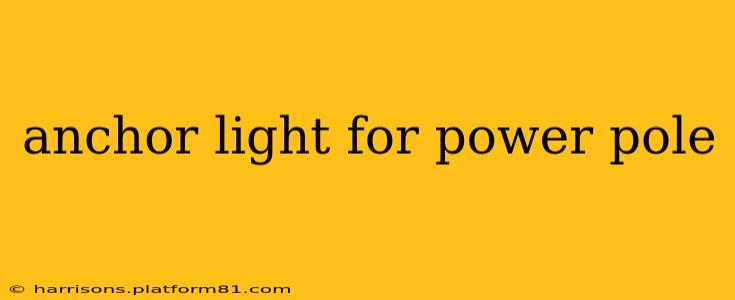Navigating at night requires reliable illumination, and for those using power poles, having a dedicated anchor light is crucial for safety and visibility. This comprehensive guide explores everything you need to know about choosing and installing the right anchor light for your power pole setup. We'll delve into different types, installation methods, and crucial considerations to ensure you're properly illuminated on the water, even after the sun sets.
What is an Anchor Light and Why Do I Need One?
An anchor light, also known as a riding light, is a navigation light required by law in most regions when a vessel is at anchor. It's a white light visible all around the horizon, indicating your vessel's position to other boaters. For power pole users, this is especially important as your anchored position might be subtly different from other anchored vessels. A dedicated anchor light on your power pole ensures maximum visibility, preventing collisions and enhancing overall safety.
What are the Different Types of Anchor Lights for Power Poles?
Several types of anchor lights are compatible with power poles:
- LED Anchor Lights: These are the most common and energy-efficient option. LEDs offer long lifespans, low power consumption, and bright illumination. Many are designed specifically for marine environments, resistant to saltwater corrosion and impact.
- Traditional Incandescent Anchor Lights: While less common now, incandescent anchor lights are still available. They tend to be less energy-efficient and have shorter lifespans compared to LEDs.
- Solar-Powered Anchor Lights: These are a convenient option, eliminating the need for wiring and a power source. However, their brightness and reliability can be affected by weather conditions and sunlight availability.
How to Choose the Right Anchor Light for Your Power Pole?
Selecting the right anchor light depends on several factors:
- Brightness: Ensure the light meets the minimum requirements specified by your region's boating regulations. Brighter lights are generally preferred for improved visibility, especially in low-light conditions.
- Power Source: Decide between battery-powered (LEDs are ideal), wired, or solar-powered options based on your power pole setup and preferences. Consider factors like ease of installation, maintenance, and battery life.
- Mounting: The light should securely attach to your power pole. Look for options with robust mounting brackets and clamps that fit your specific power pole model.
- Durability: Opt for a light constructed from marine-grade materials to withstand harsh weather conditions, saltwater exposure, and accidental impacts.
How Do I Install an Anchor Light on My Power Pole?
Installation usually involves:
- Secure Mounting: Carefully attach the light's mounting bracket to your power pole, ensuring it's firmly secured and won't loosen or fall off during use.
- Wiring (if applicable): If your light requires wiring, run the wires carefully to your power source, ensuring proper insulation and protection from water damage. Use marine-grade wiring and connectors.
- Testing: Once installed, thoroughly test the light to ensure it functions correctly and is visible from all angles.
Can I Use a Regular Boat Anchor Light on My Power Pole?
While you could potentially adapt a standard boat anchor light, it's generally recommended to choose a light specifically designed for power poles. These lights are often smaller, lighter, and more securely mounted to prevent damage or dislodging during pole operation.
What are the Legal Requirements for Anchor Lights?
Legal requirements for anchor lights vary by region and country. It is crucial to check your local boating regulations to ensure your anchor light meets all applicable standards regarding visibility, brightness, and placement. Non-compliance can result in fines.
How Do I Maintain My Power Pole Anchor Light?
Regular maintenance prolongs your light's lifespan. This includes periodically checking the wiring (if wired), cleaning the lens to maintain visibility, and replacing the batteries (if battery-powered) as needed.
By following these guidelines, you can ensure your power pole is properly illuminated, enhancing your safety and compliance with boating regulations while enjoying your time on the water. Remember to always prioritize safety and consult local regulations for specific requirements.
